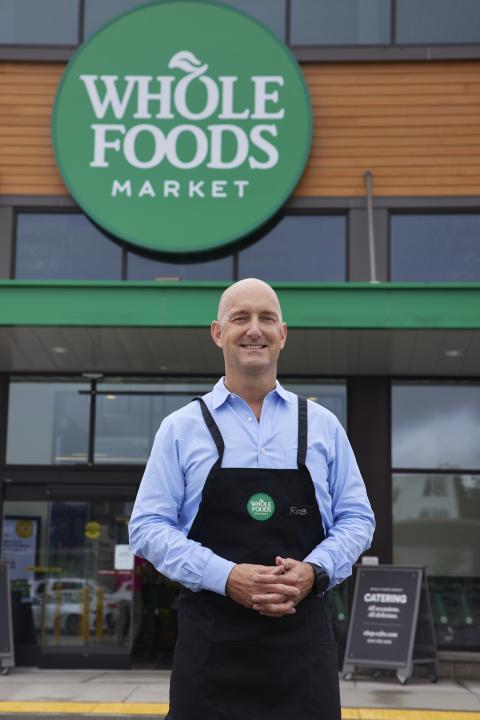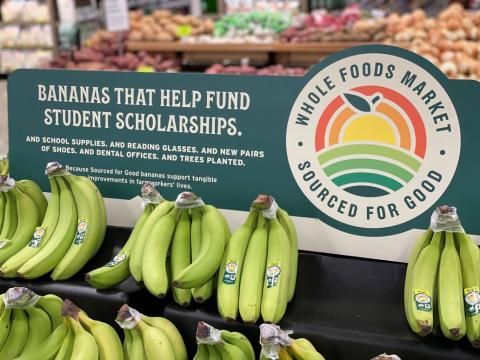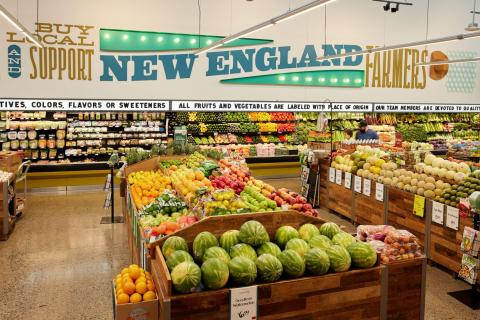‘We’re Still Whole Foods’: Life After Amazon

The story of where Whole Foods Market is headed begins where it all started: a mission to create a healthier world by selling healthier foods.
“We are a mission-based company,” says Rob Twyman, EVP/Operations at Whole Foods. “We are doing it because we believe in it. We are doing it because it is the right thing to do, and we want to effectively change the world and nourish people and planet. That is a lofty goal, but it is a real goal, it is a heartfelt goal, and it is something we are still very committed to.”
That mission has only grown stronger since Amazon shocked the grocery industry in 2017 by buying Whole Foods for $13.6 billion.
Since then, the natural foods retailer co-founded 41 years ago by CEO John Mackey in Austin, Texas, has implemented a slew of changes, some big, some small and none of them all that shocking for an Amazon-owned company: price cuts, e-commerce enhancements and operational restructuring. Through it all, however, Whole Foods has never wavered from its core mission, according to Twyman.
“Amazon still is who they are, and we’re still who we are,” he says, “and yet we’re learning from each other and growing from each other. With delivery, I think that’s a great example of where we’ve leveraged the two businesses together. They’ve helped us understand through data the different aspects of our business, and we continue to bring philosophy around food in particular that I think is important as they continue to get into the food business.”
More on delivery changes and Amazon’s grocery aspirations later.

For now, Twyman notes that Whole Foods’ path to growth is not just paved with the highest quality standards in the food retail industry. The grocer, which last year had annual sales of more than $16 billion, also aims to win by focusing on hyper-local store design and merchandising, doubling down on its bottom-up leadership style, and expanding its 528-store footprint by at least 40 stores across 19 states and Washington, D.C.
Sticking to High Standards
When Amazon bought Whole Foods, there was a lot of speculation about what the “Amazonification” of a natural food grocer with a list of banned ingredients and animal welfare practices would look like. The result has been “sort of like a marriage bringing two people together,” Twyman says. “While they create a new union, they still retain a sense of individuality. Amazon has done a great job of allowing us to do that.”
Whole Foods Market Store Count by State
Almost half of Whole Foods stores are located in 5 states, although the company has a near-nationwide presence.
State | # of Stores |
Alabama | 4 |
Arizona | 10 |
Arkansas | 2 |
| California | 92 |
Colorado | 22 |
Connecticut | 10 |
Florida | 32 |
Georgia | 12 |
Hawaii | 4 |
Idaho | 1 |
Illinois | 28 |
Indiana | 5 |
Iowa | 1 |
Kansas | 3 |
Kentucky | 2 |
Louisiana | 7 |
Maine | 1 |
Maryland | 10 |
Massachusetts | 32 |
Michigan | 7 |
Minnesota | 7 |
Mississippi | 1 |
Missouri | 4 |
Nebraska | 2 |
Nevada | 5 |
New Hampshire | 4 |
New Jersey | 22 |
New Mexico | 3 |
New York | 26 |
North Carolina | 16 |
Ohio | 12 |
Oklahoma | 3 |
Oregon | 10 |
Pennsylvania | 15 |
Rhode Island | 3 |
South Carolina | 5 |
Tennessee | 8 |
Texas | 36 |
Utah | 4 |
Virginia | 15 |
Washington | 11 |
Wisconsin | 3 |
Wyoming | 1 |
Washington, D.C. | 6 |
Total | 507 |
Source: Whole Foods Market
To prove just how much Whole Foods is still Whole Foods, the company accelerated the evolution of its quality standards this year when it launched the Sourced for Good seal, an exclusive third-party certification program that supports responsible sourcing. The Sourced for Good seal is also designed to help shoppers easily identify products that meet the high sourcing standards required by the program.
“Transparency is really important,” Twyman emphasizes, “and it’s not just about the animal or the product, it’s also about the people. The need to ensure that people are treated well and they’re making a living wage is important insofar as how we view the food that we eat. With Sourced for Good, worker welfare is a key component to that. Our goal is to expand that program to other areas and other categories.”
Whole Foods cites a recent study conducted by The Harris Poll among more than 3,000 U.S. adults, which found that 75% of Americans say when grocery shopping, it’s important to them that products are responsibly sourced, while 65% of U.S. shoppers are confused about how to determine whether a product is responsibly sourced.
The retailer’s desire to leverage these sustainability-related consumer trends can be seen not just on labels, but also in its push to operate hyper-local stores with locally focused assortments.
Hyper-Local Advantage
Whole Foods opens stores of varying sizes and selling spaces — a location could be 20,000 square feet or 70,000 square feet, Twyman points out — and that’s all by design: Despite being owned by Amazon, which operates other food retail banners such as Amazon Fresh, Whole Foods isn’t trying to be anything other than Whole Foods, he notes.
“Our stores are different sizes; they’re different formats or layouts,” he says. “There’s some markets that maybe demographically are less core customer and maybe have a higher proportion of other shoppers that aren’t the core natural food shopper, whereas in other parts of the country, you may have a very, very solid core customer, somebody who’s really looking for organic or local. And the great thing is, we have the ability to flex within our stores and be able to do that.”
According to Twyman, Whole Foods stores are designed individually to be consistent with the personality of each community.
“There’s certainly core elements that we incorporate into all our stores, but there’s always unique elements,” he observes. “In particular, the product assortment, heavy emphasis on local products, products from the local area in the community. That’s always a heavy focus for us.”
When it comes to merchandising, the retailer strives to find the perfect balance of national brands, local brands and private-brand products, which the company has been expanding into new categories.
“Our 365 private label program is an area where we are continuing to innovate with new offerings and exclusive brands,” Twyman says. “We have delved into our consumer research, evaluated category trends, knowing that a lot more people are looking for plant-based opportunities.”
Most assortments place a heavy emphasis on direct-delivery local items, however, which are called out prominently in the store with colorful signage.
Last year the company promoted Will Betts to VP of local merchandising to elevate the local program at each store; Betts partners with a team of local “foragers” in each region.
“The foragers are out there in the field to help to bring those local products,” Twyman explains. “Some of those are just great stories. They may be great stories about sustainability [or] regenerative agriculture, but they bring something to the table that’s differentiated in that way.”
Twyman notes that Whole Foods has increased its penetration of local product SKUs by 30% since 2016, adding that the retailer has the unique ability to scale those products to take them from local to global.
“Justin’s Nut Butter is a great example of this,” Twyman says. “It was a product that really started with us, and now they’re a global supplier.”
The retailer also focuses on local when it comes to its famously expansive prepared food offering. Before the pandemic, Whole Foods had perfected a unique in-store shopping experience with restaurants, bars and other experiential offerings. Twyman insists that the consumer seeking that culinary experience will be back.
“Last year, we made an additional investment in culinary, which is prepared foods and bakery,” he recounts. “We brought in Jeff Turnas, who had previously been the president of our 365 banner. Jeff has worked to build a team to support culinary focused on convenience and quality. Our prepared foods use the same ingredients, the same products, on our grocery shelves, so it’s restaurant-quality food with the same food philosophy that we have elsewhere.”

Culture Champions
Earlier this year, the company revealed a restructuring involving changes to its regional and global support teams, including the areas of corporate merchandising and operations, team member services, and technology. The global and regional merchandising teams were merged into a single team, and the team member services group was realigned for greater support in key areas such as recruiting and training.
In December, the company broke ground on a new five-story office building just east of its corporate headquarters in downtown Austin.
Twyman, who has worked for Whole Foods for more than 25 years, says that the company, which has more than 105,000 employees, attracts and seeks to elevate people who are committed to the grocer’s mission, which is not just about food transparency, but also wage transparency.
Whole Foods raised its minimum wage to $15 an hour back in 2018, and most employees know more or less what everybody else earns. It’s a practice called “wage transparency.” The average pay of professional titles of employees is published on the Whole Foods website. It’s all part of the culture of the company.

“One of the things I’m most excited about is our Culture Champion Program,” Twyman asserts. “It’s an internal education program designed to engage team members, to ensure that our culture isn’t just maintained as we grow, but that it’s alive, that it’s vibrant, that it’s evolving as we grow.”
According to Twyman, the program also offers employees a chance to understand the history of the company and the evolution of natural and organic foods.
“We have an empowering culture,” he says. “We’re not typically top-down driven. We’re really focused on bottom-up power so that team members at the store level are empowered to make decisions and be a part of the growth of the business. We have over 12,000 Culture Champions now. We just launched the program in 2018, so that is a tremendous amount of folks who have gone through it.”
The company also offers a certified cheese professional program in partnership with the American Cheese Society, a cicerone program (for beer) and a sommelier program. In addition, each of the company’s 12 regions has a meat program in which employees are learning to cut meat — something that other grocery retailers are eliminating.
“It’s becoming a lost trade in the industry, so we are continuing to create and train new butchers,” Twyman notes.

He says that when he asks employees, “What do you think about Whole Foods and what’s your experience been?” they talk about the culture and how it stems from a higher purpose.
“In terms of folks who have been with the company for a long time, it’s a compelling reason to stay with the company,” Twyman says.
Life After Amazon
Before the Amazon acquisition, Whole Foods had been reporting sales declines as more traditional food retailers entered the natural food space. Since joining the Amazon grocery ecosystem, shopper traffic and sales metrics have been harder to estimate, since the e-comm giant doesn’t provide detailed data for Whole Foods. Yet the brand is reportedly benefiting from the reopening of the economy this year. According to PacerAI, traffic to Whole Foods stores improved in May and June compared with the 2019 equivalent periods. In a July second-quarter earnings report, Amazon reported that its physical stores, which include Whole Foods Market and its other banners, increased sales by 10%.
Amazon seems to have reinvigorated not just shopper traffic at Whole Foods, but also its e-commerce operations, especially during the pandemic, when online orders have skyrocketed, and having the opportunity to try new things and fail, while smaller competitors can’t, has been key.

To wit, Whole Foods has been testing delivery-only dark stores — at least six so far — as it plays around with micro-fulfillment options. The company is also now testing a $9.95 delivery fee for Prime delivery orders in several U.S. cities.
“The goal is to cover the operating cost,” Twyman says. “Delivery costs money due to the equipment, technology, other costs. It’s something that is not sustainable; it’s an additional cost to a grocery order, and so we opted to pass that on. But we didn’t want to peanut butter it and just raise prices; we didn't feel like that was the appropriate thing to do.”
Whole Foods shoppers, whether they’re Prime members (who number 150 million in the United States and counting), are still welcome to use the retailer’s grocery pickup services at no charge, he said. According to Twyman, Amazon’s technology know-how and data analytics are “like no other, and that’s really helped us.”
“Amazon is very specific, and that approach and way of working has really helped us to be better,” he continues. “I think that’s the best of all worlds: When you bring two companies together, you want to be able to leverage what each one does best. I think that delivery, our ability to do delivery, especially during the pandemic, to be able to grow it, to be able to launch pickup in the midst of a pandemic, are examples of where the two organizations and the two cultures really met.”

Since 2017, Whole Foods has also launched numerous Prime promotions and discounts, not to mention price cuts, as it tries to get away from its “Whole Paycheck” image.
“We are continuing to look for ways to provide better prices for our customers, and certainly not at the expense of quality; we want to continue to provide the same great quality product,” Twyman says. “We work with our suppliers on that; we also work internally on our own ability to manage expenses.”
He notes that three major price investments since the Amazon acquisition, including lowering prices across all departments, have resulted in improvements in customers’ perception of the grocer’s pricing.
Now for the question that everyone wonders about when drifting off to sleep at night: What does Amazon plan to do with its Amazon Fresh grocery banner (15 locations so far), and how might that affect Whole Foods?
“There’s room for everybody to play, and I think they’re offering something a little bit different than what Whole Foods offers, and we offer something different from them,” Twyman replies. “In the long term, we’ll learn from each other, too.”






